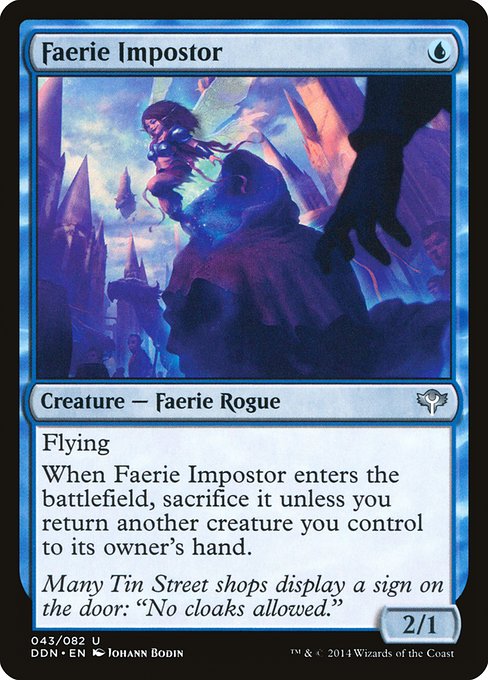
Image courtesy of Scryfall.com
How templating in Faerie Impostor shapes player understanding
Blue has always loved a clean, precise line between what a card promises and what it actually delivers. Faerie Impostor, a lean 1-mana creature from Duel Decks: Speed vs. Cunning, is a masterclass in templating that teaches players how to think in tempo, risk, and timing. Its single blue mana cost delivers flying and a deceptively simple entrance condition: When this creature enters, sacrifice it unless you return another creature you control to its owner's hand. The result is a card that telegraphs a choice—one moment of flight, one moment of memory—teaching players to anticipate, plan, and adapt. 🧙🔥
The templating is compact, almost surgical: a triggered ability that hinges on what happens the moment Faerie Impostor lands. You’re not just playing a 2/1 flier; you’re creating a small, high-stakes decision tree. Do you deploy Faerie Impostor early for air superiority and then squeeze in a quick bounce on your next turn? Or do you hold back, planning to bounce a key creature you already control, ensuring the Impostor survives as a tempo creature while you mitigate the surprise of your opponent’s attacks? This is blue’s wheelhouse: information, timing, and the art of saying “not yet” with a wink 🧊.
Templating as a mirror for deck-building instincts
- Tempo vs. strategy: Faerie Impostor rewards players who value tempo—the feel of “one more move, one more card” before the board flips. The card’s rule text nudges you toward thinking about board state and hand parity. If you can bounce another creature you control, the Impostor sticks around; if not, you’ve traded a mana advantage for card advantage elsewhere. This dynamic mirrors the broader blue ethos: use knowledge of the stack and graveyard to inch ahead.
- Resource management: Returning a creature to hand is a powerful effect, and templating makes you weigh which creature is worth saving and when. The wording implies that an extra creature you control becomes a resource to protect your tempo game. It’s a quiet reminder that every exchange has a cost, and the cost is often a creature you’ve grown to rely on in later turns.
- Engagement with the stack: The moment Faerie Impostor enters the battlefield, you must decide quickly if you’ll protect it. This engages players in the core MTG concept of the stack and triggers: you cast, your opponent responds, and a tiny puzzle unfolds on the battlefield’s stage. The card’s brevity hides a depth-of-play that rewards careful sequencing and anticipation of your opponent’s disruption 🧩.
The flavor text—“Many Tin Street shops display a sign on the door: 'No cloaks allowed.'”—gives Faerie Impostor a cheeky, urban-magical vibe. It’s a nod to the urban, opportunistic mood blue often captures: quick, clever, and a touch mischievous. The art by Johann Bodin channels a nimble, gleeful aesthetic that makes you smile even as you count the tempo on your next draw. The card’s uncommon rarity and reprint in a Duel Deck highlight how templating can persist in the metagame’s memory, becoming a familiar wall or doorway for a new generation of players to walk through with confidence 🎨.
From drafting tables to battlefield realities
When you study Faerie Impostor, you’re studying how a single line of text can shape player expectations. Its one-mana cost sits at an intersection: a flying evasive threat that also doubles as a potential resource sink. In Limited, the card teaches you to value tempo and synergy—do you prioritize pushing through a few points of damage now, or do you hold back for a more impactful seventh turn by recouping a creature you control? In Constructed, blue’s toolkit often revolves around card selection, bounce, and counterplay; Faerie Impostor fits into the mosaic as a low-curve interference piece—an initial harbinger of the tempo game to come 💎⚔️.
Designers who study templating often say that a card’s instruction should feel inevitable once you’ve internalized its rules. Faerie Impostor accomplishes this by making you internalize the consequence of a single decision: if you can bring back a creature you control, you’ll extend your board presence; if not, you’ll briefly lose your attacker to a hand-swap, setting up future plays. It’s a microcosm of MTG’s larger truth: understanding the exact words on the card is the first step toward mastering the board, the opponent, and the lingering possibilities of your next draw 🎲.
Why templating matters to readers and players today
In a sea of card texts, templating acts as the compass for new players learning the language of MTG. Faerie Impostor provides a compact, memorable template: attack with care, plan your bounce, and respect the cost of your tempo. For seasoned players, it’s a reminder of how even the smallest card can influence deck design, with implications for pacing, card advantage, and the delicate balance blue brings to a game that often feels like a dance between risk and reward. The card’s blue identity—its focus on evasion and a careful economy of resources—feels especially current in a meta where players continually reassess which lines still lead to victory and which lines merely delay defeat 🧙🔥.
As you think about how templating shapes understanding, consider the other pieces in your deck that echo this pattern: a card that asks you to momentarily suspend one plan in favor of a better future plan. That is the soul of MTG’s strategic elegance—where a single word can tilt the odds, reveal the next move, and keep the game delightfully unpredictable.
Slim Glossy Phone Case for iPhone 16 Durable LexanMore from our network
- https://crypto-acolytes.xyz/blog/post/bitcoin-in-retirement-portfolios-balancing-risk-reward-and-strategy/
- https://blog.digital-vault.xyz/blog/post/what-sells-most-on-creative-market-top-digital-download-categories/
- https://transparent-paper.shop/blog/post/a-34983-kelvin-blue-giant-anchors-the-local-standard-of-rest/
- https://blog.digital-vault.xyz/blog/post/terapagos-folklore-inspired-design-shaping-its-in-game-look/
- https://blog.digital-vault.xyz/blog/post/mastering-advanced-figma-components-and-variables-for-ui/